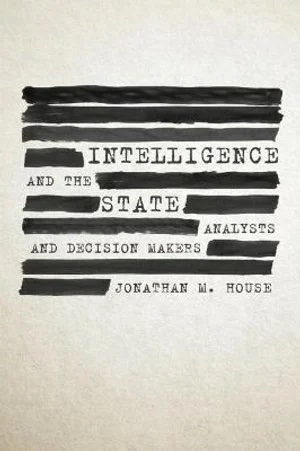
Intelligence and the State; Analysts and Decision Makers. By Jonathan M House. Naval Institute Press, Annapolis, Maryland 2022.
Reviewed by Tim Coyle
‘Intelligence and the State’ examines the often-fraught relationship between intelligence agencies and their ‘customers’ – political leaders, government officials and military commanders. There are few relationships as secretive, on the one hand and, on the other, emblazoned in media headlines as ‘intelligence failures’ after the fact. Inadequately assessed and briefed intelligence is as potentially dangerous as decision-makers over-ruling or dismissing sound intelligence advice.
Jonathan M House is a retired US Army intelligence officer having served in various Joint Staff appointments and is now an academic historian in this field. While ‘Intelligence and the State’ is focussed on the development and organisation of the US intelligence community (IC), the essentials are generally applicable globally to intelligence agencies and their customers.
The book falls mainly into three parts: chapters 1 to 3 examine the substance and skills required of intelligence practitioners, the intelligence process and the operator-analyst interface. Chapter 4 is a historical review of European precedents with chapters 5 and 6 devoted to the US IC 1882 to 1961 and beyond. The final chapter 7, The Paradox of Warning, posits some philosophic questions and imponderables, backed with recent historical examples.
Questions such as ‘is intelligence a profession?’ and the responsibilities of the profession to the State canvas the fundamentals of the tradecraft and how the intelligence product should be presented to the customers/operators. In the Intelligence Process, House discusses the familiar ‘intelligence cycle’, of which analysis is arguably the most essential and controversial as history is replete with shortfalls in intelligence analysis. Identification of intelligence cycle potential failure points, qualitative assessment grading and security classification are important components in the process.
The operator/analyst interaction is the fulcrum of effective product delivery in which perception problems and organisational constraints can be inhibitors.
Having neatly framed the ‘philosophical’ aspects of the intelligence process (with some examples as systematic failures) in the first 46 pages, House, in chapter 4, looks to European Precedents (British, French, German and Russian) and how these influenced the US IC over time.
In reviewing the history of the US IC in chapters 5 and 6, House objectively assesses their performances. The reader revisits the strategic controversaries of the 1950s through to contemporary counter terrorism and recent contingencies. In these chapters the US IC is examined in detail to the extent which some non-US readers may find overly emphasised as regards organisational changes and structure.
In the final chapter, ‘The Paradox of Warning’, House maintains the ultimate test of the intelligence structure and the relationship with decision-makers is warning of a surprise attack or the threat to national security. The Paradox is exemplified where an intelligence agency provides a flawless assessment on which decision-makers act, but the predicted event does not occur. In these circumstances the agency may be accused of ‘crying wolf’ with potential reputational damage. To expand this argument, House provides Forms of Surprises and Warnings and Methodology using examples from history – Operation Barbarossa and Pearl Harbor of 1941, Chinese intervention in the Korean war of 1950, the Cuban missile crisis and the Vietnam Tet offensive in 1962 and 1968 respectively and the Yom Kippur war of 1973.
‘Intelligence and the State’, while US-focussed, is a valuable primer for intelligence practitioners and their state instrumentality customers. Ideal for junior members of these entities, seniors will benefit by revisiting the principals which may challenge entrenched attitudes. As a former practitioner in this field, I recommend the work to those both inside and outside the ‘tent’, with or without the ‘need to know’.


